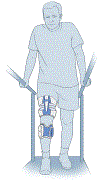Neurostimulation After Stroke
- PMID: 38514224
- PMCID: PMC11931552
- DOI: 10.1016/j.pmr.2023.06.008
Neurostimulation After Stroke
Abstract
Neural stimulation technology aids stroke survivors in regaining lost motor functions. This article explores its applications in upper and lower limb stroke rehabilitation. The authors review various methods to target the corticomotor system, including transcranial direct current stimulation, repetitive transcranial magnetic stimulation, and vagus nerve stimulation. In addition, the authors review the use of peripheral neuromuscular electrical stimulation for therapeutic and assistive purposes, including transcutaneous electrical nerve stimulation, neuromuscular electrical stimulation, and functional electrical stimulation. For each, the authors examine the potential benefits, limitations, safety considerations, and FDA status.
Keywords: Functional electrical stimulation; Motor impairment; Repetitive transcranial magnetic stimulation; Stroke rehabilitation; Transcranial direct current stimulation; Vagus nerve stimulation.
Copyright © 2023 Elsevier Inc. All rights reserved.
Figures



References
-
- Shumway-Cook A, Woollacott MH. Motor Control: Translating Research into Clinical Practice. 4th edition Wolters Kluwer Health/Lippincott Williams & Wilkins; 2012. http://catdir.loc.gov/catdir/enhancements/fy1211/2010029395-t.html. Accessed April 19, 2023.
-
- Subramaniam S, Hui-Chan CWY, Bhatt T. Effect of dual tasking on intentional vs. reactive balance control in people with hemiparetic stroke. J Neurophysiol 2014;112(5):1152–8. - PubMed
-
- Di Pino G, Di Lazzaro V. The balance recovery bimodal model in stroke patients between evidence and speculation: Do recent studies support it? Clin Neurophysiol 2020;131(10):2488–90. - PubMed
Publication types
MeSH terms
Grants and funding
LinkOut - more resources
Full Text Sources
Medical

